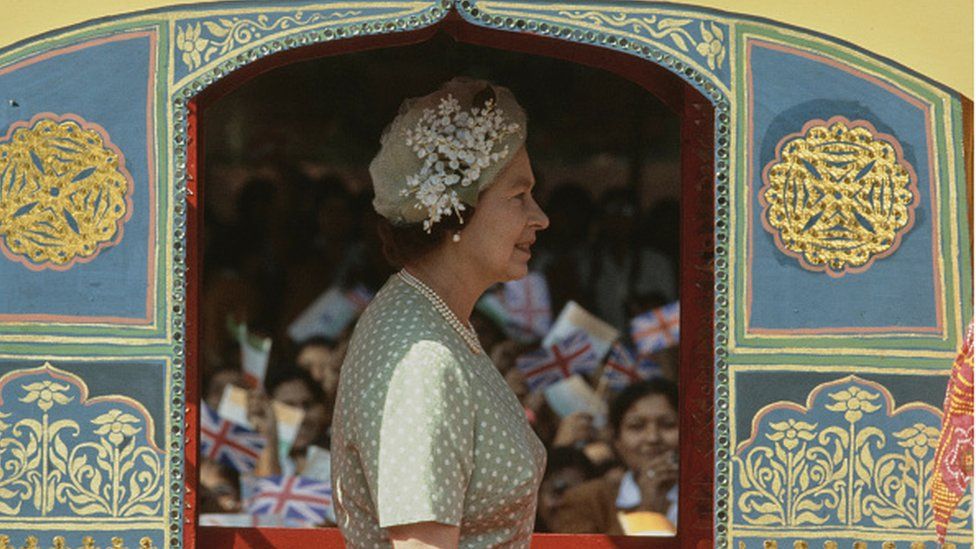 Getty Images
Getty ImagesWhen Queen Elizabeth II visited India for the first time in January 1961, the route from the airport in Delhi to the official residence of the Indian president was reportedly packed with nearly a million people.
“Indians forgot their troubles this week. Not completely, of course, but economic hardship, political squabbling and worry about Communist China, the Congo and Laos seemed to fade in the background. Queen Elizabeth II was here, and the capital, at least, appeared determined to make the most of it,” reported The New York Times.
The Times said trains, buses and oxcarts ferried people to the capital. Here they wandered on the streets and loitered on lawns hoping to catch a glimpse of the royal couple. “They seemed to look upon the Queen and Prince Philip, the Duke of Edinburgh, as impresarios who made it possible to forget and have fun,” the report said.
At the same time, the newspaper reported that “Elizabeth came not as a patronising ruler on a tour of an empire, but an equal” – she was the first British monarch to take the throne after India’s independence from British rule in 1947.

The trip also offered a chance for India to show a British ruler “that they had not done so badly since her people left”: its “jet-age airports, their new homes and office buildings, steel mills and their nuclear reactors”, for example.
For the royal couple, the six-week tour of the subcontinent was also a rich discovery of India. British Pathe footage from that trip offers a fascinating insight into the warm reception that the couple received.

The Queen toured the cities of Mumbai, Chennai and Kolkata (then known as Bombay, Madras and Calcutta) and visited historic landmarks such as the Taj Mahal, the Pink Palace in Jaipur and the ancient city of Varanasi. She attended a number of receptions and spent two days at a hunting lodge of a maharajah and rode an elephant. The royal couple were guests of honour at the grand Republic Day parade on 26 January.
At Delhi’s sprawling Ramlila Maidan, the Queen addressed a rapturous gathering of several thousand people. She rode to the Taj Mahal in Agra in an open car waving to the crowds. She visited a steel plant in West Bengal built with British aid and met its workers.
In Kolkata, she visited a monument built in the memory of Queen Victoria. A horse race at the thriving local course was organised for the couple and the Queen presented the cup to the owner of the winning horse. Covering the Queen’s ride in an open car from the airport in Kolkata to the city, a reporter of the state broadcaster AIl India Radio (AIR) quoted a Yorkshire Post editorial that she might not be the empress of India, but the enthusiasm of Indian crowds proved she was still empress of million of Indian hearts, according to an account of the trip.

Nearly two decades later, in November 1983, the Queen made her second trip to India, timed with a summit of Commonwealth leaders.
The couple stayed in the visitors suite at the opulent presidential palace which, according to a newspaper, had been stripped of its Indian furnishings and restored to the Viceregal décor. “Dusty period furniture found in offices and museums had been dusted off and repaired to deck the suite. Bed linen, curtains and tapestries have been changed to blend with the regal past,” officials said. The menu included “old, Western style dishes” because the Queen apparently liked “simple meals”.
Her final visit in October 1997 happened against the backdrop of a tragedy. Timed to mark the 50th anniversary of the independence of India and Pakistan, it was the Queen’s first public engagement since the funeral of Princess Diana.
The trip was also touched by some controversy. She was to visit Jallianwala Bagh – a memorial park that was the scene of one of the bloodiest massacres in British history – amid calls for an apology. Hundreds of Indians were shot by British troops while attending a public meeting at the site in 1919.
The night before she visited the site in the northern city of Amritsar, the Queen told a banquet reception in Delhi: “It is no secret that there have been some difficult episodes in the past – Jalianwala Bagh, which I shall visit tomorrow, is a distressing example. But history cannot be rewritten, however much we might sometimes wish otherwise. It has its moments of sadness, as well as gladness. We must learn from the sadness and build on the gladness.”

The speech – while it did not satisfy all those calling for an explicit apology from Britain – appeared to placate relatives of those killed who called off a planned demonstration at the airport in Amritsar. Instead the 10-mile route from airport to the city was reportedly lined with “cheering flag waving” people. At the city’s Golden Temple, Sikhism’s holiest shrine, the Queen was allowed to enter wearing socks after taking off her shoes.
The royal dress was a subject of unending fascination and speculation in the Indian media. During her 1983 visit, speculation was rife, reported a correspondent in India Today magazine, about almost everything the Queen wore. Sunil Sethi reported of the visit:
“The hat, the hat,” cried one of the reporters. “What is it made of?”
“Straw actually”, said an Englishman, regaining his composure.
“And the dress? What material?”
“Crepe de chine, actually”.
“Are you the Queen’s designer?,” I asked.
“Just another reporter,” he said. “He was, as I found out later, the Delhi-based correspondent of the Times of London.”
The Queen cherished her time in India during her three state visits.
“The warmth and hospitality of the Indian people, and the richness and diversity of India itself have been an inspiration to all of us,” she later said.








